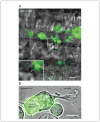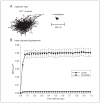Tracking quantum dot-tagged calcium channels at vertebrate photoreceptor synapses: retinal slices and dissociated cells
- PMID: 23315944
- PMCID: PMC3707139
- DOI: 10.1002/0471142301.ns0218s62
Tracking quantum dot-tagged calcium channels at vertebrate photoreceptor synapses: retinal slices and dissociated cells
Abstract
At synapses in the central nervous system, precisely localized assemblies of presynaptic proteins, neurotransmitter-filled vesicles, and postsynaptic receptors are required to communicate messages between neurons. Our understanding of synaptic function has been significantly advanced using electrophysiological methods, but the dynamic spatial behavior and real-time organization of synapses remains poorly understood. In this unit, we describe a method for labeling individual presynaptic calcium channels with photostable quantum dots for single-particle tracking analysis. We have used this technique to examine the mobility of L-type calcium channels in the presynaptic membrane of rod and cone photoreceptors in the retina. These channels control release of glutamate-filled synaptic vesicles at the ribbon synapses in photoreceptor terminals. This technique offers the advantage of providing a real-time biophysical readout of ion channel mobility and can be manipulated by pharmacological or electrophysiological methods. For example, the combination of electrophysiological and single-particle tracking experiments has revealed that fusion of nearby vesicles influences calcium channel mobility and changes in channel mobility can influence release. These approaches can also be readily adapted to examine membrane proteins in other systems.
Figures



Similar articles
-
Lateral mobility of presynaptic L-type calcium channels at photoreceptor ribbon synapses.J Neurosci. 2011 Mar 23;31(12):4397-406. doi: 10.1523/JNEUROSCI.5921-10.2011. J Neurosci. 2011. PMID: 21430141 Free PMC article.
-
L-type calcium channels in the photoreceptor ribbon synapse: localization and role in plasticity.J Comp Neurol. 1999 Dec 6;415(1):1-16. J Comp Neurol. 1999. PMID: 10540354
-
Functional Roles of Complexin 3 and Complexin 4 at Mouse Photoreceptor Ribbon Synapses.J Neurosci. 2016 Jun 22;36(25):6651-67. doi: 10.1523/JNEUROSCI.4335-15.2016. J Neurosci. 2016. PMID: 27335398 Free PMC article.
-
The molecular architecture of ribbon presynaptic terminals.Mol Neurobiol. 2009 Apr;39(2):130-48. doi: 10.1007/s12035-009-8058-z. Epub 2009 Mar 3. Mol Neurobiol. 2009. PMID: 19253034 Free PMC article. Review.
-
The dynamic architecture of photoreceptor ribbon synapses: cytoskeletal, extracellular matrix, and intramembrane proteins.Vis Neurosci. 2011 Nov;28(6):453-71. doi: 10.1017/S0952523811000356. Vis Neurosci. 2011. PMID: 22192503 Free PMC article. Review.
Cited by
-
Expression and cellular localization of the voltage-gated calcium channel α2δ3 in the rodent retina.J Comp Neurol. 2015 Jul 1;523(10):1443-60. doi: 10.1002/cne.23751. Epub 2015 Mar 10. J Comp Neurol. 2015. PMID: 25631988 Free PMC article.
-
Endocytosis sustains release at photoreceptor ribbon synapses by restoring fusion competence.J Gen Physiol. 2018 Apr 2;150(4):591-611. doi: 10.1085/jgp.201711919. Epub 2018 Mar 19. J Gen Physiol. 2018. PMID: 29555658 Free PMC article.
References
-
- Alcor D, Gouzer G, Triller A. Single-particle tracking methods for the study of membrane receptors dynamics. Eur J Neurosci. 2009;30:987–997. - PubMed
-
- Bannai H, Levi S, Schweizer C, Dahan M, Triller A. Imaging the lateral diffusion of membrane molecules with quantum dots. Nat Protoc. 2006;1:2628–2634. - PubMed
-
- Bannai H, Levi S, Schweizer C, Inoue T, Launey T, Racine V, Sibarita JB, Mikoshiba K, Triller A. Activity-dependent tuning of inhibitory neurotransmission based on GABAAR diffusion dynamics. Neuron. 2009;62:670–682. - PubMed
Publication types
MeSH terms
Substances
Grants and funding
LinkOut - more resources
Full Text Sources
Other Literature Sources

